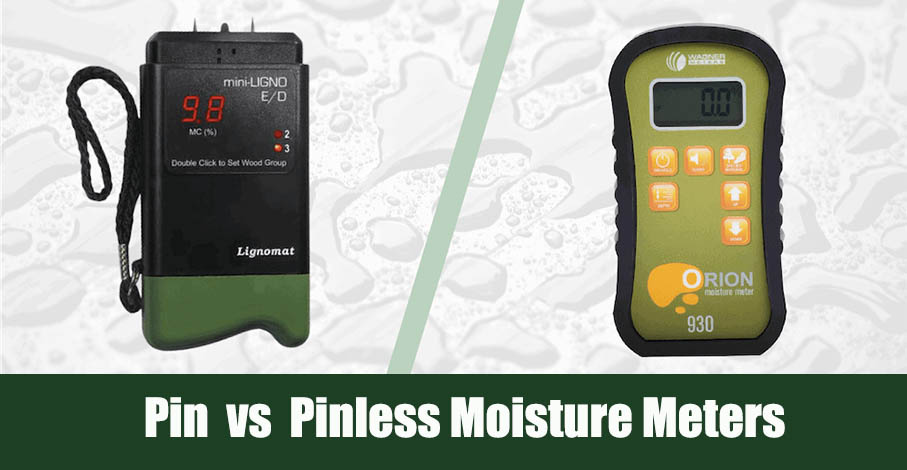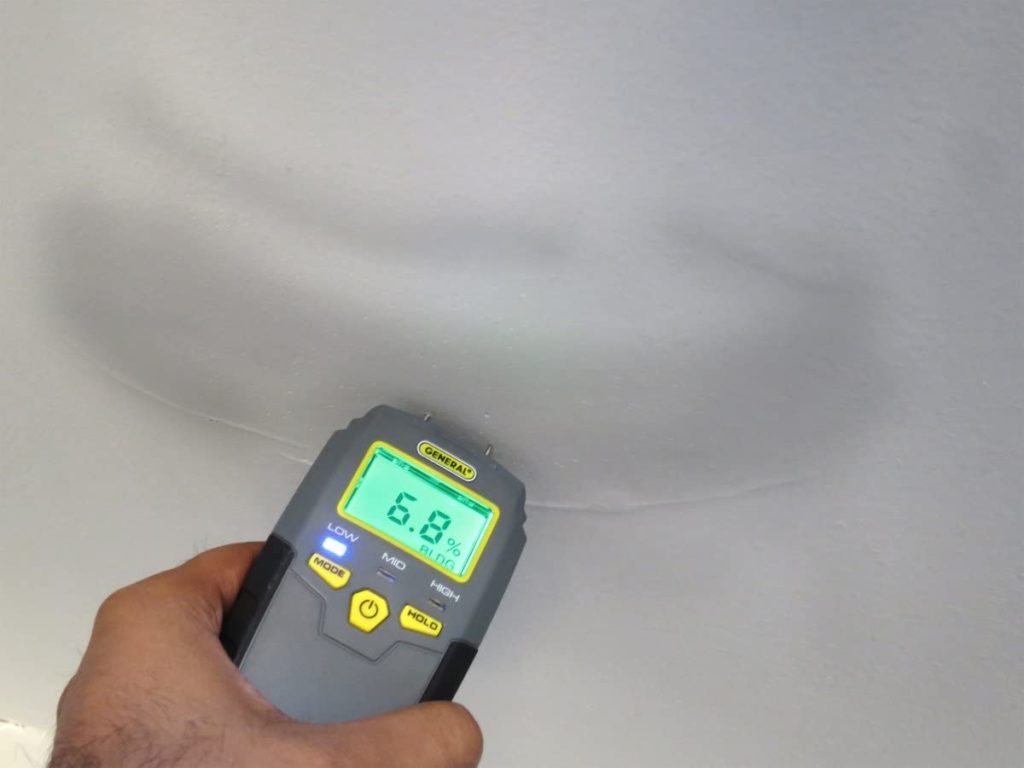Pin vs Pinless Moisture Meters: What’s the Difference?
-
Pete Ortiz
- Last updated:

If you are looking into moisture meters, you probably noticed that there are two leading types: pin and pinless. If you have never used a moisture meter before, it can be confusing as to which one to get since their difference is subtle and neither is necessarily better than the other.
The only difference between these two meter types is the probes used on the pin moisture meters. Because of these probes, pin moisture meters leave damage on the wood, but pinless moisture meters cannot read on all surfaces since they use a sensor.
To find out more about the differences between pin and pinless moisture meters and which one you should get, read on. In this article, we provide an overview of both moisture meter types and give you some helpful information on selecting a model.
Let’s probe into pin and pinless moisture meters.
Overview of Pin Moisture Meters
The main difference between a pin moisture meter and a pinless moisture meter are the probes located on the pin models. When using a pin moisture meter, you insert the two pin probes into the wall. The two probes will then get a quantifiable reading of the resistance located between the probes.
How It Works
How moisture meters work is that the probes will send an electrical current throughout the wood. The probes then detect the resistance that is encountered by that current. This method works since wood does not conduct electricity, but water does. The wetter the wood, the less resistance will occur.
Advantages
Pin moisture meters are incredibly advantageous for their more affordable price. These meters do not have as advanced technology since they do not include a sensor. This makes them the better option if you are on a tight budget.
You also don’t have to worry about the material’s surface. With the pinless models, jagged edges or other surface issues can cause a misreading since they caused the sensors to not sit correctly on the wood. Additionally, you don’t have to worry about having a dry material to compare your wood to. This will save you time.
Disadvantages
The biggest disadvantage of pin moisture meters is that you have to damage the wood in order to get the readings. Whenever you insert the pin probes, holes are then left whenever you move the meter. This can be a problem if you need to use the wood for a decorative purpose.
Another disadvantage of pin moisture meters is that they take longer to get a reading. You have to go through the hassle of inserting the probes before you actually begin the reading process. This can be timely, especially if you have never done it before.
Best Time to Use a Pin Moisture Meter
It is best to use a pin moisture meter if you are on a budget. Their more affordable price means that just about anyone will be able to afford a model. You also want to use a pin moisture meter if your material is rough or angled since pinless moisture meters cannot read on these surfaces.
More importantly, pin moisture meters are great when you measure wooden materials that are kept out of eyesight. Woods that will be used for interior frames or firewood are often great choices for using a pin moisture meter since nobody will see or care about the holes.
- Affordable
- Material surface does not affect readings
- Must damage surface to get a reading
- Takes longer to get reading
Overview of Pinless Moisture Meters
Unlike pin moisture meters, pinless moisture meters do not have probes or pins. Instead, there is a sensor on the meter that you can place on the wall of the wood. This meter gives capacitive moisture measurement instead of a resistive moisture measurement.
How It Works
Since pinless moisture meters lack pins, they use an electromagnetic signal to measure the moisture instead of resistance. An electrical wave will be sent out at a certain frequency. This creates an electromagnetic field right underneath the sensor pad. As a result, the sensor then detects return waves.
Advantages
One major advantage of a pinless moisture meter is that it does not damage the material. These sensors simply stick to the outside of the wood. You don’t have to create any holes or burrs in order to get the reading. This is incredibly advantageous if you have material that cannot be damaged.
Another advantage of this meter type is that it works really quickly. All you have to do is simply place the sensor on the outside the wood, and you will get a reading almost instantly. No need to waste time inserting pins or anything else.
Disadvantages
Even though the pinless moisture meter does not leave damage on the wood, it also comes with a downside. Most notably, it can only give you a relative moisture reading. If you want to fully understand the measurement, you have to compare the reading to a reading of the same material that is completely dry.
This can take extra time and energy, but this can be an impossible task if you don’t have access to a dry version of the material.
Another disadvantage of pinless moisture meters is that they cannot read angled, jagged, or rough surfaces. Since the sensors need to be directly flat on the wood, any disruptions to the surface will alter the readings.
Best Time to Use a Pinless Moisture Meter
You should get a pinless moisture meter if you are concerned about the surface of the wood. For example, furniture and hardwood may benefit from a pinless moisture meter over a pin moisture meter since you don’t want their surface is ruined.
You may also want to use a pinless moisture meter if you have several 2x4s to measure. Since pinless meters are faster and 2x4s are flat, using a pinless moisture meter on 2x4s will make the measuring process much easier.
- Does not damage the surface of the wood
- Almost immediate results
- More expensive
- Only gives a relative moisture reading
- Cannot give accurate results on damaged surfaces
Which Should You Get?
| Scenario | Which Meter to Get? |
| Okay to damage wood surface | Pin moisture meter |
| Cannot damage wood surface | Pinless moisture meter |
| Jagged wood surface | Pin moisture meter |
| Flat wood surface | Pin moisture meter or pinless moisture |
| Low budget | Pin moisture meter |
| High budget | Pin moisture meter or pinless moisture meter |
Both pin and pinless moisture meters give accurate results that you can depend on, but you must know how to use the models in order to use them correctly. Part of using them correctly entails selecting the meter that is best for your specific materials and needs. Though several factors can go into this choice, three factors stand out as the most important.
Damage
The most important factor you need to consider before selecting a model is whether or not the material you are measuring can have damage on the surface. If you select a pin moisture meter, the meter will leave holes and damage on the surface. Pinless moisture meters, on the other hand, do not.
You should select a pinless moisture meter if you are measuring materials that cannot be damaged. Furniture and hardwood for flooring are examples of materials that you would not want to damage. Junk wood or firewood that’s going to be cut up anyways won’t be affected by a damaged surface.
Material Surface
Another factor you need to consider when choosing a pin or pinless moisture meter is the material surface. By this, I mean whether or not the surface is rough or angled. Since pinless moisture meters use a sensor, they cannot read on surfaces that are not completely flat.
If the surface you want to measure is rough or angled in any way, you have to select a pin moisture meter to get correct readings. On the other hand, you can use either a pin or pinless moisture meter if the material is flat.
Budget
The last major factor to consider is your budget. Pin moisture meters cost notably less than pinless models. Those on a tighter budget will benefit from pin moisture meters over pinless ones. If you do not have a budget, then you can select either.
What to Consider In a Moisture Meter: Accuracy
When choosing a moisture meter, the most important factor to consider is accuracy. If your meter is not accurate, you will not be able to get results that are helpful to your projects. It is best to assess the accuracy of a model based on manufacturer claims and product reviews.
Look at manufacturer claims for any tests that have been conducted to test the accuracy and effectiveness of the model. At the same time, read user reviews to see if they found the moisture meter to be as accurate as the manufacturer claimed.
How to Read Moisture Meters
Even if you run the meters correctly, they are useless if you don’t know how to read them. You must understand exactly what your meter is telling you in order to use the information.
No matter what moisture meter you select, the most important data point will be the moisture content percentage. In other words, the data will tell you how much moisture is present relative to the material you are measuring. In order to get an accurate result, you have to set the meter based on the species you are measuring.
If you get a more advanced model, it may be able to provide data on things like humidity or air temperature. Still, the moisture content will be the most important reading.
Quick Look: Our Top Choices
| Rating | Image | Product | Details | |
|---|---|---|---|---|
Our Favorite Pin Moisture Meter

|

|
General Tools MMD4E Digital Moisture |
|
CHECK PRICE |
Our Favorite Pinless Moisture Meter

|

|
Wagner Meters Orion 910 Pinless Moisture Meter |
|
CHECK PRICE |
Our Favorite Pin Moisture Meter: General Tools MMD4E Digital Moisture Meter
This General Tools moisture meter is an affordable and accurate moisture meter. It provides accurate readings with a measurement range of 5 to 50% for wood and 1.5 to 33% for other materials. At the same time, this moisture meter is incredibly easy to use because of its digital screen. It includes a 0.3 inch backlit LCD display, making it much easier to get a clear reading. This is a great tool for mold prevention and moisture detection. All the while, the product is highly affordable.
Our Favorite Pinless Moisture Meter: Wagner Meters Orion 910 Deep Depth Pinless Wood Moisture Meter Kit
The Wagner Pinless Moisture Meter Kit is a highly accurate, versatile, and high quality moisture meter that does not leave materials damaged. The meter includes a relative measurement mode for non solid wood measurement applications, so you can use it on treated wood or other materials. It also comes with an on-demand calibrator, meaning that you can easily calibrate the model for enhanced accuracy. Though this moisture meter is expensive, it is highly accurate and comes with a 7 year warranty.
Final Thoughts
Pin moisture meters and pinless moisture meters are great ways to measure the moisture content of wood and other materials, meaning you can use them for moisture detection and mold prevention. The only difference between these moisture meters is the pins. Obviously, pin moisture meters have pin probes, while pinless moisture meters do not.
Though neither model is inherently better than the other, you should use a pin moisture meter if you are on a budget or are measuring a material with rough surfaces. In contrast, pinless moisture meters are superior if you need to measure material that cannot get damaged.
Contents








